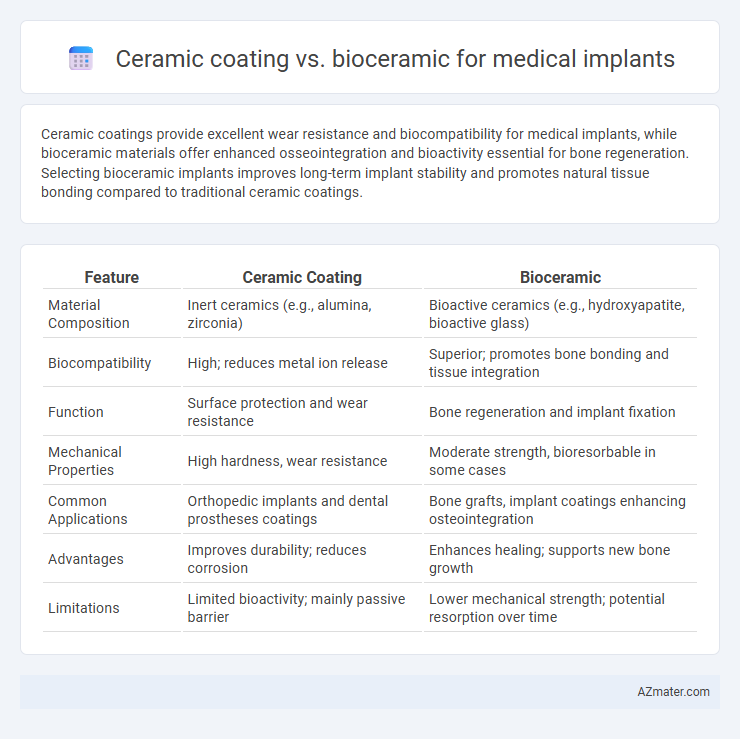Ceramic coatings provide excellent wear resistance and biocompatibility for medical implants, while bioceramic materials offer enhanced osseointegration and bioactivity essential for bone regeneration. Selecting bioceramic implants improves long-term implant stability and promotes natural tissue bonding compared to traditional ceramic coatings.
Table of Comparison
| Feature | Ceramic Coating | Bioceramic |
|---|---|---|
| Material Composition | Inert ceramics (e.g., alumina, zirconia) | Bioactive ceramics (e.g., hydroxyapatite, bioactive glass) |
| Biocompatibility | High; reduces metal ion release | Superior; promotes bone bonding and tissue integration |
| Function | Surface protection and wear resistance | Bone regeneration and implant fixation |
| Mechanical Properties | High hardness, wear resistance | Moderate strength, bioresorbable in some cases |
| Common Applications | Orthopedic implants and dental prostheses coatings | Bone grafts, implant coatings enhancing osteointegration |
| Advantages | Improves durability; reduces corrosion | Enhances healing; supports new bone growth |
| Limitations | Limited bioactivity; mainly passive barrier | Lower mechanical strength; potential resorption over time |
Introduction to Medical Implant Coatings
Medical implant coatings, including ceramic and bioceramic types, enhance biocompatibility, corrosion resistance, and mechanical stability of implants such as orthopedic, dental, and cardiovascular devices. Ceramic coatings typically consist of materials like alumina or zirconia, offering excellent hardness and wear resistance, while bioceramic coatings often incorporate bioactive materials such as hydroxyapatite to promote bone integration and biological compatibility. Selection of coating type depends on the specific implant application requirements, ensuring improved implant longevity and patient outcomes.
Overview of Ceramic Coating Technology
Ceramic coating technology enhances the biocompatibility and durability of medical implants by applying a thin, wear-resistant layer of ceramics such as titanium oxide or zirconia. These coatings improve corrosion resistance and promote osseointegration, crucial for long-term implant stability in orthopedic and dental applications. Bioceramic coatings specifically use bioactive materials like hydroxyapatite to further stimulate bone growth and accelerate healing around the implant site.
Understanding Bioceramic Materials
Bioceramic materials, such as alumina and zirconia, are engineered to improve biocompatibility and mechanical strength in medical implants, outperforming traditional ceramic coatings that primarily serve as surface protectants. These bioceramics actively promote osseointegration and reduce inflammatory responses, making them ideal for orthopedic and dental applications. Understanding their chemical composition and structural properties is crucial for optimizing implant longevity and patient outcomes.
Surface Properties: Ceramic vs. Bioceramic
Ceramic coatings for medical implants offer high hardness, chemical stability, and wear resistance, which enhance implant longevity and biocompatibility. Bioceramic materials, such as hydroxyapatite, improve surface bioactivity by promoting osseointegration and tissue bonding due to their chemical similarity to natural bone. The surface roughness and porosity of bioceramics create bioactive interfaces, while traditional ceramics primarily provide passive protective barriers.
Biocompatibility and Tissue Integration
Bioceramic materials, such as hydroxyapatite and zirconia, exhibit superior biocompatibility compared to traditional ceramic coatings, promoting enhanced tissue integration and reducing inflammatory responses. Their chemical affinity to bone tissue accelerates osteointegration, resulting in stronger and more stable implant fixation over time. Ceramic coatings primarily act as protective barriers but often lack the bioactive properties necessary to facilitate direct cellular bonding and long-term tissue regeneration.
Mechanical Strength and Durability
Ceramic coatings on medical implants provide high mechanical strength due to their hardness and wear resistance, ensuring long-term durability under physiological loads. Bioceramic materials, such as hydroxyapatite, offer enhanced biocompatibility and osteoconductivity while maintaining sufficient mechanical stability to support bone integration and reduce implant failure. The choice between ceramic coating and bioceramic depends on the required balance of mechanical robustness and biological performance in implant applications.
Corrosion and Wear Resistance
Ceramic coatings and bioceramic materials both enhance corrosion and wear resistance in medical implants, with ceramics providing a dense, inert barrier that effectively protects underlying metals from bodily fluids and mechanical stress. Bioceramics, such as alumina and zirconia, exhibit superior wear resistance due to their high hardness and fracture toughness, reducing particle release and implant degradation over time. Corrosion resistance in bioceramics surpasses traditional ceramic coatings as their chemical stability minimizes ion leaching and inflammatory responses within the biological environment.
Antimicrobial and Antifouling Performance
Ceramic coatings for medical implants provide excellent antimicrobial properties by creating a durable surface that resists bacterial adhesion and biofilm formation, crucial for reducing infection risks. Bioceramic materials enhance antifouling performance through their bioactive nature, promoting osseointegration while minimizing protein adsorption and microbial colonization. Studies demonstrate bioceramic coatings, such as hydroxyapatite or zirconia-based composites, outperform traditional ceramic coatings in sustaining long-term antimicrobial efficacy and preventing implant-related infections.
Cost and Manufacturing Considerations
Ceramic coatings for medical implants generally offer lower manufacturing costs due to established deposition techniques and readily available raw materials, making them cost-effective for large-scale production. Bioceramic coatings, while more expensive because of complex synthesis processes and higher purity requirements, provide superior bioactivity and compatibility, justifying their use in premium implant applications. Cost efficiency in ceramic coatings contrasts with the advanced manufacturing demands and material costs associated with bioceramics, influencing the selection depending on clinical needs and budget constraints.
Clinical Applications and Future Trends
Ceramic coatings provide excellent wear resistance and biocompatibility, making them suitable for orthopedic and dental implants to enhance durability and reduce inflammation. Bioceramics, composed of bioactive materials like hydroxyapatite, promote bone integration and regeneration, proving advantageous in bone grafts and implant fixation. Future trends focus on nanostructured ceramic coatings and multifunctional bioceramics that combine antimicrobial properties with improved osteoconductivity for enhanced clinical outcomes.

Infographic: Ceramic coating vs Bioceramic for Medical implant
 azmater.com
azmater.com